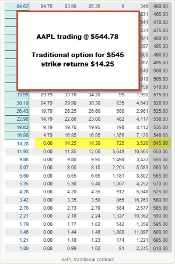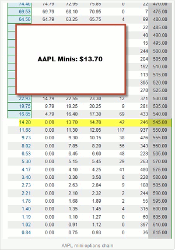Option expert Alan Ellman of TheBlueCollarInvestor.com takes the newish mini options for a spin to see how they perform relative to traditional options.
Our stock options strategies have a new product to consider: mini options. These options have a deliverable 10 shares of underlying security instead of the traditional 100 shares. The options symbol for these minis begin with the security ticker followed by the number 7:
The five securities below are the only ones currently available with mini options although many more will follow. These new products allow average retail investors to sell covered call options without having to lay out huge sums of money to purchase the underlying shares. For example, to sell one covered call option for Apple Computer would require us to invest over $50,000 to enter the long stock position. With minis that investment would be reduced to $5,000.
- AAPL7
- AMZN7
- GOOG7
- GLD7
- SPY7
My initial concern, as with the introduction of all new products, is the liquidity of trading and how that impacts the bid-ask spreads. My second, specifically with minis, is the question of commissions. Will the brokerages reduce commissions since the per-share amount would be 10x greater if they didn’t…they didn’t. In today’s article, I will use Apple Computer (AAPL) to demonstrate the impact that lower liquidity, higher bid-ask spreads, and higher per-share commissions have on our annualized returns. At the time that I am writing this article, AAPL was trading @ $545.78 and the March 2014 monthly contracts were five weeks away from expiration. Here is the options chain for the traditional monthly contract with 100 shares deliverable:
Please note for the near-the-money $545 strike:
- High open interest of 3,526 contracts
- Tight bid-ask spread of $0.05 ($14.25 – $14.30)
- Premium generated from sale of a covered call is $14.25 per share
Next, let’s take off our shoes and socks and do some math per contract:
- ROO (before commissions) = $1425/$54,478 = 2.62%, five-week return
- ROO (after a $10 commission) = $1415/$54,478 = 2.60%, five-week return, 26% annualized
- Commission resulted in a return reduction of 0.02%
***ROO = initial return on option or initial profit
Next, let’s have a look at the options chain for the minis, also for March 2014 expiration with 10 shares deliverable:
Please note for the near-the-money $545 strike:
- Significantly lower open interest of 246 contracts
- Much wider bid-ask spread of $1.00 ($13.70 – $14.70)
- Premium generated from sale of a covered call is $13.70 per share, $0.55 less than the traditional option
Next, let’s calculate:
- ROO (before commissions) = $137/$5447.80= 2.51%, five-week return
- ROO (after a $10 commission) = $127/$5447.80 = 2.33%, five-week return, 23.3% annualized
- Commission resulted in a return reduction of 0.18%
Annualized difference in returns:
- Traditional: 26%
- Minis: 23.3%
- Traditionals outperform minis by 2.7%
Amazon stats:
I then ran the same process using AMZN as the underlying when the stock was trading @ $357.20 and looking at the $360 strike for both the traditional and mini options. The result was even more significant with the traditionals outperforming the minis by an annualized rate of 4.7%.
Conclusion
Using the mini options at the current time will allow us to take positions in the five securities with a much lower cash investment. However, the returns will suffer because of the impact of commissions and wider bid-ask spreads due to lower option liquidity. I do believe that this liquidity will increase as time goes by, thereby decreasing bid-ask spreads and perhaps brokerages will lower commissions for these products. In the interim, choosing other underlying securities that will generate higher returns may be the prudent approach.
By Alan Ellman of TheBlueCollarInvestor.com























